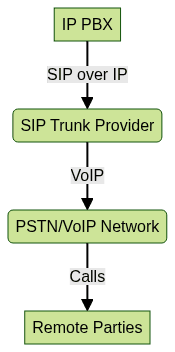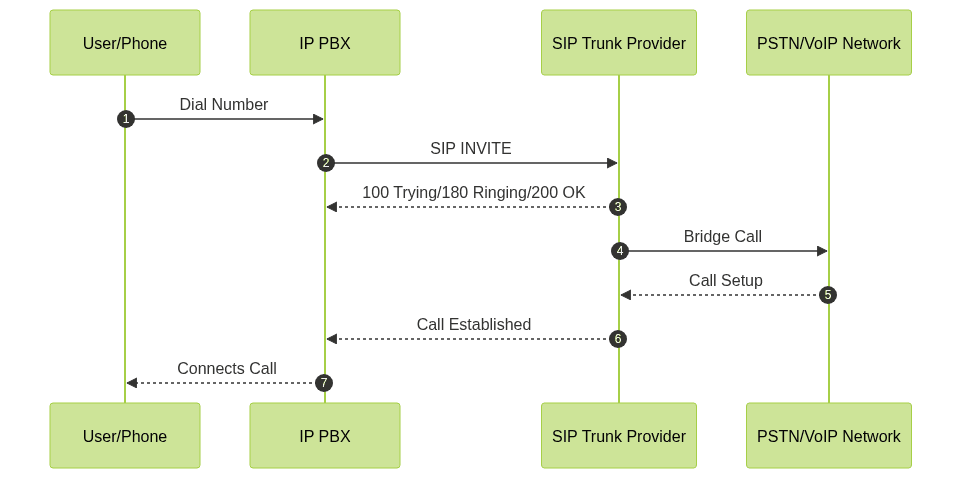Telephone SIP Trunk: The Complete Guide for Modern Business Communication (2025)
Introduction to Telephone SIP Trunk
The shift from legacy phone lines to digital communications has revolutionized business telephony. A telephone SIP trunk is a modern technology that enables businesses to transmit voice, video, and messaging over the internet using Session Initiation Protocol (SIP). Unlike traditional PSTN (Public Switched Telephone Network) lines, SIP trunks leverage VoIP (Voice over IP) to connect an organization’s private branch exchange (PBX) directly to the public telephone network via the internet.
The evolution from analog and ISDN lines to SIP trunking has enabled organizations to consolidate communications, reduce costs, and gain unprecedented flexibility. In 2025, SIP trunking is a critical component of scalable, cloud-enabled business phone systems, supporting everything from remote work to global expansion.
What is a SIP Trunk?
SIP trunking is a method for delivering telephone and unified communications services over the internet, replacing traditional phone lines. SIP (Session Initiation Protocol) is an application-layer signaling protocol used to establish, manage, and terminate real-time sessions, including voice and video calls.
A "trunk" in telephony refers to a bundle of voice channels shared between users. In SIP trunking, these channels are virtual, traversing IP networks instead of copper wires. Each SIP channel represents a concurrent call path—so a 10-channel SIP trunk supports 10 simultaneous calls.
For businesses looking to enhance their communication stack, integrating a
phone call api
can streamline voice interactions and enable advanced call features directly within your applications.Key Terminology
- SIP: Protocol for initiating, maintaining, and ending communication sessions.
- Trunk: Aggregated communication channels between two points.
- Channel: Single call path within a trunk.
Basic SIP Trunk Architecture

This architecture illustrates how the IP PBX connects to the SIP trunk provider, enabling calls to flow between the internal network and external parties via the internet or public telephony networks.
SIP Trunking vs Traditional PSTN
Traditional PSTN, ISDN, and analog lines rely on physical infrastructure, offering limited scalability and flexibility. In contrast, SIP trunking utilizes IP networks, enabling dynamic allocation of channels and seamless integration with cloud-based and on-premises phone systems.
Businesses aiming to provide seamless voice experiences can benefit from a
Voice SDK
, which allows for the rapid development of high-quality audio solutions that work alongside SIP trunking.Key Differences
- Cost: SIP trunks eliminate the need for multiple physical lines, reducing rental and call charges.
- Scalability: Add or remove channels instantly without rewiring.
- Flexibility: Integrate with cloud PBX, remote work, and advanced call routing.
For companies that require both voice and video communication, leveraging a
Video Calling API
can further enhance collaboration by embedding video conferencing capabilities into your business applications.Feature Comparison Table
| Feature | PSTN/ISDN | SIP Trunking |
|---|---|---|
| Line Rental | High | Low |
| Scalability | Limited | Dynamic |
| Setup Time | Weeks | Hours |
| Number Portability | Complex | Simple |
| Integration | Legacy Systems | Modern Apps/Cloud |
| Disaster Recovery | Difficult | Built-in Options |
How Telephone SIP Trunk Works
A SIP trunk connects your IP PBX to a VoIP provider, allowing inbound and outbound calls over the internet. When a user dials a number, the IP PBX formats the call as a SIP request and routes it through the SIP trunk provider, who then bridges the call to the PSTN or another VoIP endpoint.
For developers building custom telephony solutions, exploring a
callkit tutorial
can simplify the process of integrating native calling features on iOS devices, ensuring a seamless user experience.SIP Call Flow Example
Here’s a simplified SIP INVITE example illustrating how a call is initiated:
1INVITE sip:1234567890@siptrunk.provider.com SIP/2.0
2Via: SIP/2.0/UDP 203.0.113.10:5060;branch=z9hG4bK-524287-1---d6a12d
3From: "Alice" <sip:alice@company.com>;tag=1234
4To: <sip:1234567890@siptrunk.provider.com>
5Call-ID: 987654321@company.com
6CSeq: 1 INVITE
7Contact: <sip:alice@203.0.113.10:5060>
8Content-Type: application/sdp
9Content-Length: ...
10
11[v=0, o=alice, s=call, c=IN IP4 203.0.113.10, m=audio ...]
12SIP Trunk Call Flow Diagram

Benefits of Telephone SIP Trunk for Businesses
Modern businesses gain substantial advantages by adopting SIP trunking:
- Cost Savings: Reduce line rental and call rates compared to PSTN. SIP trunks consolidate voice traffic, lowering operational expenses.
- Flexibility & Scalability: Instantly add or remove SIP channels to match business needs, supporting seasonal spikes or growth.
- Number Portability: Retain existing numbers regardless of physical location, simplifying office moves or remote work setups.
- Enhanced Disaster Recovery & Redundancy: Built-in failover options route calls to backup locations or mobile phones during outages.
- Integration with Modern Tools: Seamlessly connect SIP trunks with CRM, analytics, call recording, and cloud PBX systems for improved productivity.
If your organization is looking to
embed video calling sdk
into your existing platforms, SIP trunking can serve as the foundation for both voice and video communications.These benefits position SIP trunking as the backbone for unified communications and future-proof business phone systems.
Key Features to Look for in a SIP Trunk Provider
Choosing the right SIP trunk provider is critical for reliable communication. Consider the following features:
- Reliability & Uptime: Look for providers offering 99.99%+ uptime with global infrastructure and redundancy.
- Security Features: Essential protections include SIP over TLS/SRTP, fraud detection, and DDoS mitigation.
- Number Porting Capabilities: Ensure smooth migration of existing phone numbers.
- Support & Integration: 24/7 technical support and compatibility with leading IP PBX and cloud platforms.
- International Coverage: If you operate globally, confirm international numbers and local presence.
For advanced voice applications, integrating a
Voice SDK
can help you build scalable, interactive audio rooms and conferencing features that complement your SIP trunk setup.Evaluating these criteria ensures your business communication remains robust, secure, and adaptable.
Setting Up a Telephone SIP Trunk: Step-by-Step Guide
Prerequisites
- Compatible IP PBX (e.g., Asterisk, FreePBX, 3CX)
- Reliable internet connection
- SIP trunk account from a provider
- SIP-enabled phones or softphones
When setting up your SIP trunk, you may also want to consider how a
phone call api
can be integrated to automate call flows or enable click-to-call features within your business applications.Basic SIP Trunk Configuration Example
Here’s a sample SIP trunk configuration for Asterisk:
1[my-sip-trunk]
2type=peer
3host=siptrunk.provider.com
4username=myuser
5secret=mypassword
6fromuser=myuser
7fromdomain=siptrunk.provider.com
8context=from-trunk
9insecure=invite,port
10qualify=yes
11encryption=yes
12nat=yes
13Setup Steps
- Configure IP PBX: Enter SIP trunk provider details in the PBX admin interface.
- Define Dial Plans: Set rules for inbound/outbound call routing.
- Register SIP Trunk: Authenticate with the provider.
- Test Calls: Place test calls to verify connectivity and audio quality.
- Troubleshooting: Use PBX logs and SIP trace tools to resolve issues like one-way audio or registration failures.
For businesses that require video as well as voice, integrating a
Video Calling API
during setup can streamline the deployment of unified communications across your organization.Proper setup and testing are vital for call quality and reliability.
SIP Trunk Security Best Practices
As SIP trunks are exposed to the internet, security is paramount to protect against threats such as DoS attacks and toll fraud.
- Encrypt SIP Signaling and Media: Use TLS for SIP signaling and SRTP for media streams.
- Deploy Firewalls & SBCs: Session Border Controllers (SBCs) act as gatekeepers, filtering malicious traffic.
- Monitor & Alert: Track call patterns, usage, and unauthorized access attempts in real time.
To further secure your telephony infrastructure, consider leveraging a
phone call api
that offers built-in security features and compliance with industry standards.Staying vigilant and proactive is essential to safeguard your business communications.
SIP Trunk Use Cases & Migration Scenarios
Migration from PSTN/ISDN
Many organizations migrate from legacy PSTN or ISDN lines to SIP trunks to modernize infrastructure, reduce costs, and enable cloud PBX integration.
For teams developing custom VoIP solutions, reviewing a
callkit tutorial
can be invaluable for implementing native call interfaces on iOS devices during migration.Reseller & Multi-Site Deployments
SIP trunks empower resellers to offer scalable voice solutions and allow multi-site businesses to centralize telephony, simplify management, and enable remote call forwarding between locations.
If your deployment spans multiple locations, integrating a
phone call api
can help manage distributed call routing and analytics from a single platform.Choosing the Right SIP Trunk Solution
Selecting a SIP trunk solution involves evaluating several factors:
- Cost Structure: Assess per-channel pricing, call rates, and hidden fees.
- Feature Set: Ensure required capabilities like number portability, redundancy, and call analytics.
- Support & Integration: Choose providers with responsive support and compatibility with your existing systems.
Evaluation Checklist:
- Uptime SLA
- Security protocols
- Number porting ease
- International/local coverage
- Integration with your PBX
If you're ready to modernize your communications,
Try it for free
and experience the benefits of SIP trunking and unified communications firsthand.Conclusion
Telephone SIP trunking is a game-changer for business communications in 2025, delivering cost savings, flexibility, and robust integration. Now is the perfect time to evaluate and upgrade your telephony to a modern SIP trunk solution.
Want to level-up your learning? Subscribe now
Subscribe to our newsletter for more tech based insights
FAQ